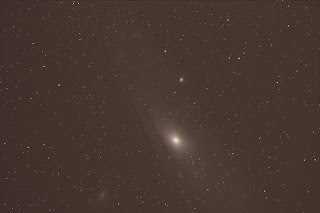The image was made by stacking nine exposures each 90 seconds for a total time of 14.5 minutes. The autoguider worked perfectly as the stars show no trailing.
Image 1 - Raw Crop
Image 2 - Raw from DSS
Image 3 - JPEG from DSS
Image Details:
Images 1 - 3:
M27 - The Dumbbell Nebula (mag +7.5)
Location: Monroe, CT
Date/Time: 8/12/15 11:38 PM
Camera: Canon EOS Rebel T3i
Telescope: Orion ED80 80mm f/7.5 Apochromatic Refractor Telescope
Mount: Orion Sirius EQ-G GoTo Telescope Mount
Autoguiding: Orion StarShoot G3 attached to and Orion Short Tube 80mm
Focal Length: 600mm
f/7.5
Exposure: 9-90s (total exposure, 14m30s)
ISO: 1600
Post Processing: DSS, PS (crop)
I did manage to get a shot of a meteor during my viewing session and some shoot of the faint Milky Way from my light polluted front yard in southern Connecticut.
Image 4 - Meteor is just below M31
Image 5 - Milky Way
Image 6 - Milky Way














